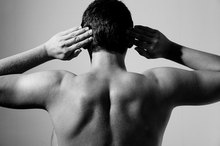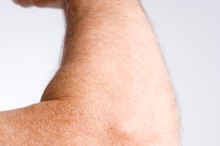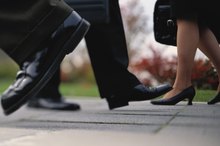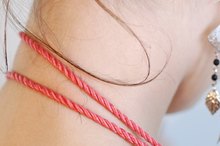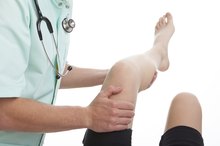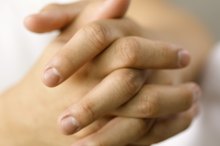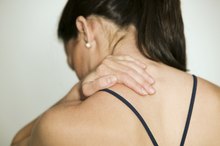Symptoms of Forearm Tendinitis
The symptoms of forearm tendinitis in a person’s forearm are described with his or her palm facing up. Tendinitis is frequently used to classify pain from several types of tendon injuries or diseases. More specifically, tendinitis is an inflammation of a person's tendon, which can heal with treatment. Tendinosis occurs when an injured or inflamed tendon does not heal properly and begins to deteriorate, causing pain.
Lateral Pain and Tenderness
Pain and tenderness located on the lateral border or thumb side of a person’s forearm and elbow is commonly referred to as "tennis elbow." This affects the extensor muscles and tendons on the posterior surface of the forearm; these muscles and tendons are responsible for bending the back of the hand toward the back of the forearm. A person will experience pain when he grips something or bends his wrist backward. In severe and prolonged cases, pain will increase at rest, his grip strength will decrease, and he will be unable to bend and straighten his elbow, according to Sandra Shultz, Ph.D., and colleagues, in the book “Examination of Musculoskeletal Injuries.”
- Pain and tenderness located on the lateral border or thumb side of a person’s forearm and elbow is commonly referred to as "tennis elbow."
- In severe and prolonged cases, pain will increase at rest, his grip strength will decrease, and he will be unable to bend and straighten his elbow, according to Sandra Shultz, Ph.D., and colleagues, in the book “Examination of Musculoskeletal Injuries.”
Medial Pain and Tenderness
How to Put a Dislocated Shoulder Back Into Place
Learn More
Repetitive actions, such as baseball pitching and swinging a golf club, cause pain, tenderness and swelling on the medial or little-finger side of a person’s elbow and forearm. This condition is commonly referred to as "golfer’s elbow." It affects the flexor muscles and tendons, which enable the person to bend the palmar surface of the hand toward the front of the elbow. A person may experience tingling and numbing sensations from her elbow down to her ring and little fingers, according to a 2010 article entitled "Golfer's elbow," published on MayoClinic.com. It may also be difficult for her to rotate her forearm to face her palm upward and downward.
- Repetitive actions, such as baseball pitching and swinging a golf club, cause pain, tenderness and swelling on the medial or little-finger side of a person’s elbow and forearm.
- A person may experience tingling and numbing sensations from her elbow down to her ring and little fingers, according to a 2010 article entitled "Golfer's elbow," published on MayoClinic.com.
Wrist Pain and Tenderness
Pain and tenderness of tendons in the forearm and crossing the wrist may result from overuse and repetitive motions such as typing or gripping heavy objects. A person with the wrist tendinitis may also experience swelling on the anterior aspect of his wrist. He may hear clicking and grading sounds. The inflammation limits the ability of his tendons to glide smoothly in his wrist, creating much discomfort. Bending and stretching his wrist will cause pain. If this condition does not heal properly, the scar tissue will permanently thicken and decrease the range of motion in his wrist, Schultz warns.
- Pain and tenderness of tendons in the forearm and crossing the wrist may result from overuse and repetitive motions such as typing or gripping heavy objects.
Related Articles
References
- “Examination of Musculoskeletal Injuries”; Sandra Shultz, Ph.D., Peggy Houglum, Ph.D., and David Perrin, Ph.D.; 2005
- Mayo Clinic: Golfer's Elbow
- Amin NH, Kumar NS, Schickendantz MS. Medial epicondylitis: evaluation and management. J Am Acad Orthop Surg. 2015;23(6):348-55. doi:10.5435/JAAOS-D-14-00145
- Tarpada SP, Morris MT, Lian J, Rashidi S. Current advances in the treatment of medial and lateral epicondylitis. J Orthop. 2018;15(1):107-10. doi:10.1016/j.jor.2018.01.040
- Brady C, Dutta A. Medial epicondylitis and medial elbow pain syndrome: Current treatment strategies. J Musculoskelet Disord Treat. 2016;2:014.
- Barco R, Antuña SA. Medial elbow pain. EFORT Open Rev. 2017;2(8):362-71. doi:10.1302/2058-5241.2.160006
- Sorani A, Campbell R. Image-guided elbow interventions: a literature review of interventional treatment options. Br J Radiol. 2016;89(1057):20150368. doi:10.1259/bjr.20150368
- Tsai WC, Tang ST, Liang FC. Effect of therapeutic ultrasound on tendons. Am J Phys Med Rehabil. 2011;90(12):1068-73. doi:10.1097/PHM.0b013e31821a70be
- Sahu RL. Percutaneous golfer's elbow release under local anesthesia: a prospective study. Rev Bras Ortop. 2016;52(3):315-8. doi:10.1016/j.rboe.2016.06.007
Writer Bio
Paula Quinene is an Expert/Talent, Writer and Content Evaluator for Demand Media, with more than 1,500 articles published primarily in health, fitness and nutrition. She has been an avid weight trainer and runner since 1988. She has worked in the fitness industry since 1990. She graduated with a Bachelor's in exercise science from the University of Oregon and continues to train clients as an ACSM-Certified Health Fitness Specialist.
